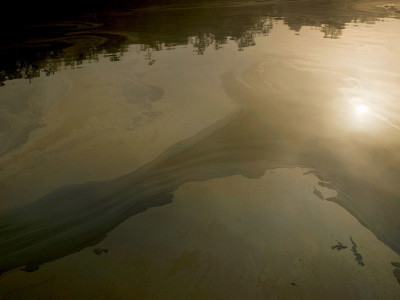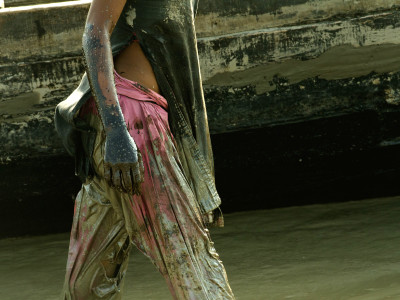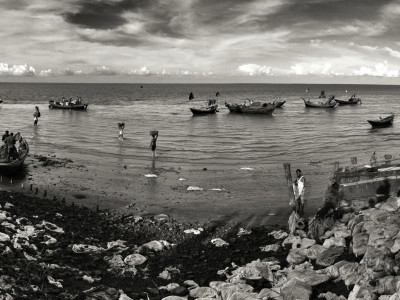The Trailhead
Winter in Upper Assam was long gone, leaving behind only a hint of a nip in the fierce pink of the gloaming. The river Subansiri, making its way down from Tibet to join the Brahmaputra, flowed fat and placid. In the orchid-swathed forests, clumps of fern rose black and feathery against the fiery sky. From the far bank, a boatman, standing tall in a long low dugout, ferried seven people across using a bamboo pole as oar.
Trucks wheezed and grumbled along raw roads of scree, carrying towering piles of smooth round rock. The grey dust of their passing obscured small-scale factories pulverizing rock for cement. Great quantities of cement for dams, for roads, for buildings.
Light was fading fast. We jumped into our car at the urging of the driver and headed back to Lakhimpur. This was “the elephant hour” and in an area famous for “angry rogue elephants at twilight”, our driver was scared. With me was Professor Hazarika, a fish scientist, who had no such apprehensions. As we crested a bridge over a stream, he motioned for the driver to halt. He jumped out of the car and ran down the bank. I followed.
Decline Of Species
We rushed across the soft sand, past massive footprints of elephants, to an area with a smudge of water. He crouched at its edge and carefully moved a small river rock.
Two baleful eyes stared back at us – a snakehead fish, about as long as my index finger, heavy with eggs. “This is an endangered species,” he explained.
Little indigenous fish like the snakehead find refuge, eat, and breed around river rocks and fallen logs, in the nooks and crannies of soft-flowing streams, and in coves. These are prime habitat for the fish. “If you take those ‘obstacles’ away, you destroy vital fish breeding habitat.”
The rock-laden trucks we had seen earlier in the day now loomed in my mind as much more than noisy, dusty nuisances. Mining rock from rivers was destroying habitat and endangering species. Prof Hazarika had discovered another fish that was just 16mm long — among the smallest in the world — that was in danger of becoming extinct even before science had properly recorded it. In fact, threats to freshwater biodiversity in the northeast cannot be accurately determined due to “lack of sufficient data” on a lot of species.
Fish are not the only endangered species. The blind Gangetic dolphin, India’s designated “national aquatic animal”, is the top predator of these rivers and depends on fish for sustenance. Dwindling numbers of its natural prey put it at risk. It seeks out areas where the fish are. Fishermen, similarly hurting from falling catches, also seek out the same places. Man meets predator head to head and what ensues is a prize-fight for fish.
Moreover, despite a ban against killing the dolphin, this charismatic animal is hunted, its oil used as bait for catching catfish. This combination of circumstances has earned it a place in the IUCN Red List of Threatened Species..
Elsewhere, the critically endangered gharial, and economically important species like the hilsa and tiger shrimp, hang on to a precarious existence threatened by habitat destruction and various anthropogenic activities.
While large scale river-use change like dams and barrages pose the greatest danger to these and other species, they are by no means the only threat.
The Chalakudy river in the Western Ghats has the highest number of endemic species of fish in the world, including varieties not found anywhere else. These are now threatened by severe industrial pollution and a renewed threat of a dam; they are also under assault by a sinister invader from Africa.
The Tilapia, native to the Nile, is a fish-farmer’s darling. A non-fussy eater, a fast grower, and with a taste rather acceptable to most palates, the tilapia is widely farmed in India. Having found its way into the wild, this invasive species is now proliferating rapidly, monopolizing the food supply, and driving local fish to extinction.
Add these varied threats together and, worldwide, freshwater species are now more endangered than are terrestrial species.
],[https://www.peepli.org/wp-content/uploads/2015/04/howtheydie-1000x750.jpg,(large)])
The Endangered Fisherman
"It's No Fish Ye're Buying – it's Men's Lives”
With the supply of small indigenous fish declining by 85-90% over the past decade, fishermen are sliding into poverty. They cannot find enough fish in the river to sell, much less to eat.
In the markets of Dibrugarh, 90% of the fish are trucked in, on beds of ice, from farms in Andhra Pradesh. This is no exception: most cities on the banks of the mighty, once highly biodiverse Brahmaputra now import the bulk of their fish from farms.
The sociological and economic hit the river fisheries are taking is no small matter, and this story is repeating itself all over the sub-continent. A few months after my trip to Assam, I saw whole fishing villages going hungry along the Teesta River in Bangladesh. India’s barrage upstream impounds vital water, desiccating the lower riparian country in the dry season. No water, no fish. No fish, no money. No money, no food.
When I traveled to the Bangladeshi Sundarbans, the largest mangrove forest in the world, the story was no different. The area was once a nursery for fish, shrimp and crabs but now, along the delta, the rivers ran empty. I heard fishermen lament the “worst season in 35 years”, which meant “I will never be able to repay my debts” — a crushing verdict on the shrinking fish supplies and its impact on their lives.
On the Indian side, entire stretches of rivers have seen species disappear and fisheries collapse. Around the Farakka barrage I met fishermen who now eked out a precarious living as daily-wage laborers. They had been forced to abandon their traditional livelihood when the barrage stopped the immensely lucrative hilsa fish from migrating upstream to spawn. The hilsa, which not so long ago could be found as far upstream as Allahabad, has now disappeared entirely from the upper reaches of the Ganges, leaving fishermen bereft.
Like the hilsa, the eel, the shrimp, and other diadromous fish, which migrate to spawn, are worst hit by concrete manmade interruptions like dams and barrages. The loss of these species is not only a loss of biodiversity – they are economically important. For example, the hilsa contributes 1.5% of Bangladesh’s GDP.
These species are also the mainstay of millions of small, traditional fishermen, and their disappearance hurts more than just their pockets. Such fish are the only source of protein in already impoverished diets. Over the last year, I have met women and men, children and the elderly who, having lost protein from their diets, are severely undernourished. The impact of the decline of freshwater fish on the longterm health of communities living along rivers is increasingly evident – and the risks are escalating.
],[https://www.peepli.org/wp-content/uploads/2015/05/hands_fish-1000x1000.jpg,(large)])
Onward!
If you could create a giant cube and pack into it all the drinking water in the world, that cube would fit nicely into the city of Bangalore. All of the waters in the world’s rivers, lakes, and wetlands are only a fraction of that, fitting inside a cube with a side of only 13km.
We wear a very thin freshwater skin. Rupture it, defile it, scar it, drain it, and we will hurt badly. Over half the world’s population lives within 20 km of a river – and in this industrial age, everyone wants a piece of these freshwater bodies. Dams, diversions, irrigation canals, reservoirs, industries, fishing, mining, fish-farming, invasive species, deforestation, declining biodiversity, degraded livelihoods — this is what rivers in the anthropocene era look like.
Rivers, by their very nature, are sensitive to changes in the landscapes they drain. Small changes in those landscapes affect river flows. Changes in river flows have a cascading effect on creatures, people, and in turn, landscapes. Add to this the unpredictability of weather patterns in the age of climate change. If predictions of intensification of weather events bear out, the effect of increased cloudbursts, storms, floods, and droughts on human-altered riverine ecosystems could be disastrous.
I grew up privy to raucous debates between my uncles and my dad on the merits and demerits of large dams and their impacts on lives and rivers. Those conversations must have burned themselves deep into my psyche because, as a young graduate, one item topped my bucket list of ‘Things I will do when I grow up’: Traverse down the major river systems of India, documenting lives lived.
It has taken a few decades for that mind-magma to bubble forth to the top.
When the urge to learn and explore did finally erupt, I promised myself one thing: That I would give places time; that I would give myself time to let these places reveal things about themselves, about me. That I would follow stories and lives, not reduce them to snapshots in time. That I would make space for natural narrative trajectories that change over seasons, years, decades.
When I visited Upper Assam last year on a recce trip, I had a whole lot of research behind me, but still had only a vague notion of ground realities. I have spent smidgeons of time now with various rivers — the Chalakudy, the Brahmaputra, the Teesta, the Ganges — and themes are beginning to emerge, and resonate.
As Rainer Maria Rilke said of art — and it is true of storytelling too,
“In this there is no measuring with time, a year doesn’t matter, and ten years are nothing.”
This is especially so when we tell stories of lands and landscapes, of lives lived and of the arcs ecosystems follow. In keeping with my promise to myself, I will criss-cross the Indian sub-continent over time; watching, learning, waiting, documenting the state of our freshwater — rivers, lakes, aquifers and wetlands.
I will follow nation-states as they execute plans to use the land and the water, and document how these changes affect both the ecosystem and the livelihoods inextricably linked to it.
And I will take you along on this journey. It may be long, with switchbacks and plunges and smiles and tears, but it will take us into the lives of others. Together we will hear, and see; we will meet the people — the fishermen and the moneylenders and the farmers and migrants and refugees and landlords and volunteers and nomads.
… These are stories of the lifeblood of our land.
The Stories, Mapped
],[https://www.peepli.org/wp-content/uploads/2015/02/mighty_2048-1000x563.jpg,(medium)],[https://www.peepli.org/wp-content/uploads/2015/02/mighty_2048-1600x900.jpg,(large)])








[…] theme is freshwater — our rivers, lakes and other water-bodies, groundwater… The linked story below that (indicated in the image above with an orange exclamation point) is prologue to her next […]